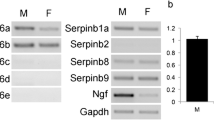Abstract
Expression of the dominant allele, Ssp Sat the Sex-limited saliva pattern locus in mice results in an alteration of the electrophoretic mobility of a mouse salivary protein from the F (fast) to the S (slow) type [Karn, R. C., et al. (1980). Genetics 94:s52; Karn, R. C., et al. (1982). Biochem. Genet. 20:493]. We now demonstrate that the protein affected binds androgen and has a basic heterodimeric structure with the subunits connected by disulfide bridging. It is produced in the submaxillary gland where the alteration takes place. The change in electrophoretic mobility from F to S appears to be primarily the result of an increase in the molecular weight of the larger subunit since the isoelectric point changes very little. We discuss the possible causes of the increase in molecular weight.
Similar content being viewed by others
References
Dlouhy, S. R., and Karn, R. C. (1983). TCP (Testosterone controlled protein): The structural gene for the mouse salivary protein under the influence of Ssp (Sex-limited saliva pattern). Fed. Proc. 421046.
Heyns, W., Bossyns, D., Peeters, B., and Rombants, W. (1982). Study of a proline-rich polypeptide bound to the prostatic binding protein of rat ventral prostate. J. Biol. Chem. 2577407.
Heyns, W., Peeters, B., and Bossyns, D. (1983). Multiple forms of the proline-rich polypeptide (PRP) bound to rat prostatic binding protein. Biochem. Biophys. Res. Comm. 111172.
Karn, R. C. (1981). Sex-limited effects of the expression of the db gene in mice during puberty. Biochem. Genet. 19355.
Karn, R. C., Hjorth, J. P., Nielsen, J. T., Springer, K. R., and Dlouhy, S. R. (1980). The sex-limited expression of a salivary protein in mice. Genetics 94s52.
Karn, R. C., Dlouhy, S. R., Springer, K. R., Hjorth, J. P., and Nielsen, J. T. (1982). Sex-limited genetic variation in a mouse salivary protein. Biochem. Genet. 20493.
Kueppers, F. (1976). Determination of α1-antitrypsin phenotypes by isoelectric focusing in polyacrylamide gels. J. Lab. Clin. Med. 88151.
Laemmli, U. K. (1970). Cleavage and structural proteins during the assembly of the head of bacteriophage T4. Nature 227680.
Laskey, R. A., and Mills, A. D. (1975). Quantitative film detection of 3H and 14C in polyacrylamide gels by fluorography. Eur. J. Biochem. 56335.
Matsushima, Y., and Ikemoto, S. (1981). Biochemical genetic marker and sex difference in mouse salivary protein. Jap. J. Zootech. Sci. 52566.
Matsushima, Y., and Ikemoto, S. (1982). Genetic analysis of mouse salivary protein system-1 (Msp-1). Jap. J. Zootech. Sci. 53617.
Parker, M., Needham, M., and White, R. (1982). Prostatic steroid binding protein: Gene duplication and steroid binding. Nature 29892.
Passmore, H. C., and Shreffler, D. C. (1970). A sex-limited serum protein variant in the mouse: Inheritance and association with the H-2 region. Biochem. Genet. 4351.
Verhoeven, G., and Wilson, J. D. (1976). Cytosol androgen binding in submandibular gland and kidney of the normal mouse and the mouse with testicular feminization. Endocrinology 9979.
Author information
Authors and Affiliations
Additional information
SRD was supported in part by PHS General Medical Training Grant T32 GM07468 and the Indiana University School of Medicine Research Program in Academic Medicine. RCK was supported by PHS Career Development Award 1 K04 AM00284.
Rights and permissions
About this article
Cite this article
Dlouhy, S.R., Karn, R.C. The tissue source and cellular control of the apparent size of androgen binding protein (Abp), a mouse salivary protein whose electrophoretic mobility is under the control of Sex-limited saliva pattern (Ssp). Biochem Genet 21, 1057–1070 (1983). https://doi.org/10.1007/BF00488459
Received:
Revised:
Issue Date:
DOI: https://doi.org/10.1007/BF00488459




